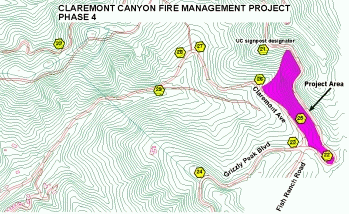UC Berkeley Press Release
Thousands of invasive trees cleared in UC Berkeley fire project
BERKELEY – At a time when the traditional fire season is in full swing, the University of California, Berkeley, is wrapping up a fire prevention project this month that will remove almost 6,000 eucalyptus trees from the hills surrounding the campus.
The $100,000 Claremont Canyon Phase 4 project, done in collaboration with PG&E and the Claremont Canyon Conservancy, a local homeowners group, is one part of a 10-year plan to ultimately remove more than 25,000 eucalyptus trees from UC Berkeley property.
The non-native eucalyptus trees are aggressive growers and are particularly dangerous in a fire. Once ablaze, the gummy trees tend to "explode," spewing out blazing material that can land miles away, sparking new fires.
 Eucalyptus trees in this section at the top of Claremont Canyon (shaded in map, below) are being cleared as part of a fire prevention project intended to reduce the risk of disastrous wildfires in the hills above the UC Berkeley campus. (Photo courtesy Peter Klatt; map courtesy UC Berkeley Office of Emergency Preparedness)  |
The latest phase is clearing eucalyptus trees in the area between Claremont Avenue and Grizzly Peak Boulevard, just beyond the intersection with Fish Ranch Road above the Caldecott Tunnel. The disastrous 1991 Oakland Hills fire that destroyed 3,400 homes and killed 25 people burned in this area, stopping about 80 feet inside the southern border of UC Berkeley property.
"After the '91 fire, there was a recommitment to the idea that we needed to manage the East Bay hills aggressively and in collaboration with our neighbors," said Tom Klatt, manager of UC Berkeley's Office of Emergency Preparedness.
Among those neighbors is the 200-member Claremont Canyon Conservancy. Many members lost their homes in the 1991 fire, according to Tim Wallace, president of the Claremont Canyon Conservancy and a former director of the California Department of Agriculture.
PG&E started work on this project in July, and removed 195 trees that were located within 10 feet of the company's power lines.
"We promote the idea of 'the right tree in the right place,'" said Dee McDonough, vegetation program manager for PG&E. "Our aim is to provide safe and reliable service to all of our customers, and by removing eucalyptus trees, we're removing the likelihood of limbs falling and interrupting service or even causing a fire."
UC Berkeley owns a total of about 850 acres of wildland in the hills that stretch from Claremont Canyon along the southern edge of campus to Strawberry Canyon to the north. The fire prevention work so far has been on roughly 100 acres.
In Claremont Canyon, contracted workers are removing eucalyptus from a 13-acre area, leaving behind coastal redwoods, bay laurel trees, various oaks, maple madrone, hazelnut, and elderberry buckeye trees that had been dwarfed by the towering canopy created by the 100-plus foot eucalyptus groves. The cut areas have also opened up stunning westward vistas that sweep from the city of San Francisco to Mt. Tamalpais.
"When we cut the eucalyptus, we discovered a whole raft of redwoods, about 250 of them, and the Conservancy has planted 50 more," said Wallace, adding that the original redwoods were planted in the 1970s by a local Rotary group. The Conservancy has 1,000 redwood seedlings to plant in the canyon over the next year.
The eucalyptus groves have been cleared out before. Klatt said many of today's eucalyptus re-sprouted from stumps left over from the early 1970s, when a bad freeze prompted widespread cutting of damaged eucalyptus trees. The aggressive tree can grow up to 15 feet a year.
To prevent regrowth, the stumps are sprayed with an herbicide immediately and will be treated again twice a year as part of ongoing maintenance.
The Phase 4 Claremont Canyon project will be complete by the end of the month. The next phase, scheduled to begin in late summer 2005, will involve removing eucalyptus from a 10-acre parcel south of Claremont Avenue, contiguous with areas already cleared.
Illustrating the need for this kind of work, a eucalyptus tree in Claremont Canyon fell in March 2004, downing a power line and sparking a wildfire that burned through a ridgetop eucalyptus stand before being put out.
The remains of the cut trees are being used to line roadways and paths, placed along the hillsides for erosion prevention and as habitat for some insects and lizards, while wood chips are retained as groundcover to suppress poison oak and weeds.
"It's environmentally friendly and sustainable," Klatt said. "Retaining the biomass on-site recycles the organic material and eliminates trucking expenses and related traffic impacts."
Other fire prevention work on campus has been in collaboration with the East Bay Municipal Utilities District; the cities of Oakland, Berkeley and El Cerrito; East Bay Regional Park District; East Bay Municipal Utility District; Lawrence Berkeley National Laboratory; the California Department of Forestry and Fire Protection; the U.S. Fish and Wildlife Service and the California Department of Fish and Game.

